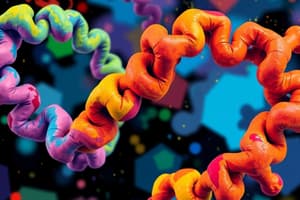Podcast
Questions and Answers
What is the primary structure of a protein?
What is the primary structure of a protein?
- The three-dimensional structure of a polypeptide
- The local spatial arrangement of a polypeptide's backbone atoms
- The association of subunits in the tertiary structure
- The sequence of amino acids linked by a peptide bond (correct)
What is required to break peptide bonds nonenzymatically?
What is required to break peptide bonds nonenzymatically?
- Enzymatic reaction
- Heating and high concentrations of urea
- Prolonged exposure to a strong acid or base at elevated temperatures (correct)
- Cooling and low concentrations of urea
How many possible unique polypeptide chains of 100 residues are there?
How many possible unique polypeptide chains of 100 residues are there?
- 20^100 ≈1.27 ×10^130 (correct)
- 20^10 ≈1.27 ×10^13
- 20^50 ≈1.27 ×10^65
- 20^20 ≈1.27 ×10^26
What determines the 3D structure of a protein?
What determines the 3D structure of a protein?
What is the minimum number of residues a protein typically contains?
What is the minimum number of residues a protein typically contains?
What is the function of oxytocin?
What is the function of oxytocin?
What is the number of amino acids in oxytocin and vasopressin?
What is the number of amino acids in oxytocin and vasopressin?
What is the definition of a peptide?
What is the definition of a peptide?
What is the primary function of vasopressin in the kidney?
What is the primary function of vasopressin in the kidney?
What is the role of glutathione in biological systems?
What is the role of glutathione in biological systems?
What is the characteristic of the peptide bond?
What is the characteristic of the peptide bond?
What is the consequence of the peptide bond's partial double-bond character?
What is the consequence of the peptide bond's partial double-bond character?
Which bond angles are freely rotatable in a polypeptide chain?
Which bond angles are freely rotatable in a polypeptide chain?
What is the significance of the omega angle in a peptide bond?
What is the significance of the omega angle in a peptide bond?
What is the purpose of the Ramachandran plot?
What is the purpose of the Ramachandran plot?
What are the sterically forbidden conformations in a polypeptide chain?
What are the sterically forbidden conformations in a polypeptide chain?
Flashcards are hidden until you start studying
Study Notes
Protein Structure Levels
- Primary structure: the sequence of amino acids linked by a peptide bond
- Secondary structure: local spatial arrangement of a polypeptide's backbone atoms without regard to the conformations of its side chains
- Tertiary structure: three-dimensional structure of an entire polypeptide, including its side chains
- Quaternary structure: association of subunits in the tertiary structure to form multimeric protein
Primary Structure
- Sequence of amino acids in a protein is called the primary structure of the protein
- Peptide bonds are resistant to heating and high concentrations of urea
- Prolonged exposure to a strong acid or base at elevated temperatures is required to break these bonds nonenzymatically
- Theoretical possibilities for polypeptides are unlimited (20n possible sequences for a protein of n residues)
- Amino acid sequence determines the 3D structure of a protein
Biologically Active Peptides
- Oxytocin and vasopressin are biologically active peptides (hormones) composed of 9 amino acids
- Oxytocin: uterine contraction during labor & promoting milk release during lactation
- Vasopressin: antidiuretic hormone; increases water reabsorption in the kidney & promotes the constriction of blood vessels, thereby increasing blood pressure
- Glutathione: a tripeptide with antioxidant activity, maintaining sulfhydryl groups of proteins in the reduced state and the iron of heme in the ferrous (Fe2+) state
Peptide Bond Characteristics
- Peptide bond has a partial double-bond character, making it rigid and planar, preventing free rotation around the bond
- Bonds between the α-carbons and the α-amino group (Cɑ-N) or between the α-carbons and α-carboxyl groups (Cɑ-C) can be freely rotated
Ramachandran Plot
- The Ramachandran Diagram indicates allowed conformations of polypeptides based on sterically allowed values of φ and ψ
- Sterically forbidden conformations have φ and ψ values that would bring atoms closer than the corresponding van der Waals distance
Studying That Suits You
Use AI to generate personalized quizzes and flashcards to suit your learning preferences.



